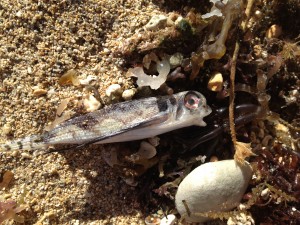Latest Update: 7/10/2014
On July 10th, Division of Aquatic Resources (DAR) staff visually inspected additional sites near Nanakuli, Oahu. DAR has thus far received 14 reports through the Eyes of the Reef Network from several locations on Oahu and one on Kauai. DAR will continue to monitor incoming reports of dead gurnards.

Yellow pins indicate a report made through the Eyes of the Reef Network. DAR has received 14 public reports of dead gurnards since 7/1. Map credit: DAR
7/3/2014
On July 1st and 2nd, the Division of Aquatic Resources (DAR) received several reports through the Eyes of the Reef Network and the Oahu Monk Seal Foundation of dead fish washing up on beaches in Waikiki, Ko Olina, and Nanakuli on the island of Oahu.
On July 2nd and 3rd, DAR staff responded to the reports by visiting the sites and visually surveying the Koolina and Waikiki area. Several juvenile (2-3 inches) flying gurnard (Dactyloptena orientalis) samples were collected from Waikiki and Ko Olina for laboratory tests. Mortality events can be caused by a number of factors, including environmental stressors, natural cycles, predation, or disease. Samples from this event are currently being processed by US Geological Survey (USGS) and preliminary laboratory results are expected in 2-3 weeks.
Gurnards are naturally found in sandy environments and feed on invertebrates at night. Adults can grow to over a foot long.
DAR is encouraging the public to report observations of these fish through the Eyes of the Reef Network, using their online report forms. Please do not collect samples.

Flying gurnard on the beach in Waikiki showing sharp barbs. Please do not touch or handle, these barbs can cause injury.
These fish have sharp barbs that can cause puncture wounds, do not attempt to touch or handle. Photos are very useful to these reports. If you have photos of your observation, you can send them to [email protected].
Updates about the gurnard reports will appear on the Reef Response website.
